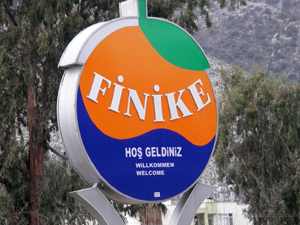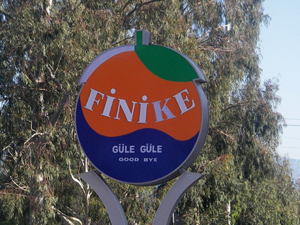|
|
|
Winter in Turkey |
|
|
Our winter in Turkey has been very exciting and at the same time and eye opener. What picture did we have of the country and its’ people?, Well, that its’ people hadn’t got as far in their development as the rest of Europe. A poor country where you still travelled by horse and cart. A country where you were frowned upon if you came from the “outside”. Perhaps they were even unpleasant? We couldn’t have been more wrong! We have been treated with the utmost politeness and kindness and everybody has been very helpful. The larger towns/cities have been “hyper modern”, e.g. Antalya. As a contrast we have been in smaller villages where the development hasn’t reached that far. Turkey is a big country, which is described below, and naturally there is a lot of variation. The following applies when meeting other people: “You are treated the same way you treat other people”. A smile always comes back… And now to our experiences mixed with other things. |
|
|
Hos Geldiniz |
|
|
Welcome! That’s what it says on the sign when you get into Finike. There are just over 11 000 inhabitants here and the size suits us just right. The town is not a typical tourist attraction, with all that entails, and you see people in their every day life. What was really noticeable on our first walk was how clean it was everywhere. No litter, plenty of litter bins and a lot of benches and tables where to sit and have a rest.
|
|
|
Here we see benches with “Finke Belediyesi” written on them. This means Finike Municipality. They are made out of concrete and don’t need a lot of maintenance.
|
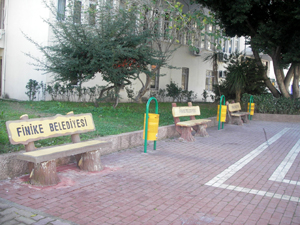 |
|
There is a little canal through the centre of town with a lot of small bridges over it. These are also made out of concrete, although they look as if they are made of wood. Clean and tidy with a lot of flowers and greenery to enhance the experience.
|
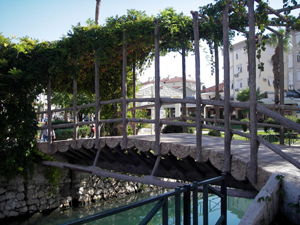 |
|
The Flag |
|
|
High above the town the Turkish flag “flutters” on the cliff face. It is always interesting to find out why a flag looks the way it does, which is why I have done a little bit of research. The current design of the flag is derived from the Ottoman flag. Turkey was a part of the Ottoman Empire between 1250-1923. Several designs were used with one or more crescents and the background colour differed, e.g. green background for religious institutions and red of the secular part. The eight-pointed star was replaced to the five-pointed 1844 and the flag reached the form of the present day flag. The crescent and the star are symbols of the Turks. There are many legends about how the design of the flag was derived. Common for the legends is that the moon and the star were reflected in a pool of blood and that this was the way the symbol of the country was born. This is not strange considering the bloody history of the country.
|
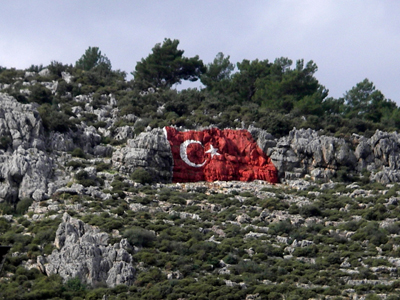 |
|
A few facts about the country: |
|
|
Turkey is a rectangular country with an area of 780,578 km2 . 3% of it is in Europe and is called “Thrace” and the remaining 97% is in Asia and is called “Anatolia”. The country borders, Georgia, Armenia, Nakhichevan (area between Armenia and Iran), Iran, Iraq, Syria, Greece and Bulgaria. According to statistics from 2004 there were 71 152 000 inhabitants that year. The religion is Islam and the average length of life is 73 years. As you can see it is a very big country and we have only scratched a little part of it!
|
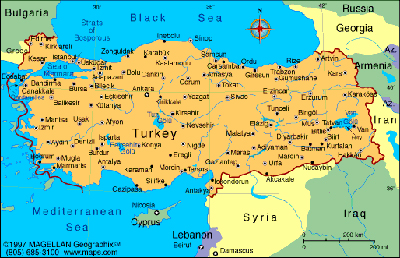 |
|
Activities |
|
|
The sailor’s own social club at the marina, The Porthole Club, has arranged a lot of activities for us “live-aboards”. Apart from many outings to interesting places we have also had the opportunity to increase our knowledge in many different ways. Here a few examples: lessons in Turkish or French, painting classes, guitar classes, interesting lectures in many different areas, several types of training (gymnastics, yoga or pilates), quiz nights, darts, BBQ:s every Sunday, etc. All of this every week. A lot to choose from and we haven’t had time to join everything, but quite a lot anyway.
|
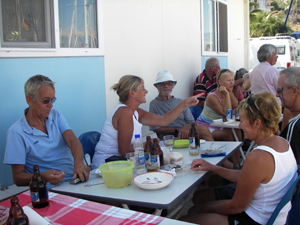 |
|
Canoe outing |
|
|
It is a long time since we were out canoeing, so when “Solhumla” arranged a trip we joined. One of the most exciting parts was the drive out to the river…
|
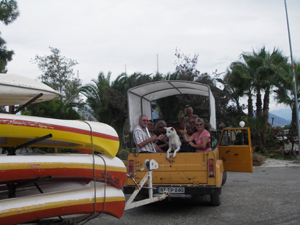 |
|
It was heavenly just quietly gliding along and being so near to nature. You can’t see it in the picture, but we were paddling past orange groves. Lovely.
|
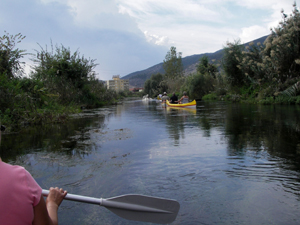 |
|
A part of the way we were struggling through a “jungle”…
|
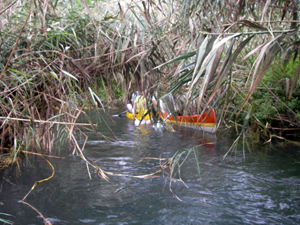 |
|
Trade |
|
|
Finike is situated in a very fertile area between two mountainous areas, Alaca Dag and Görece Dag, belonging to the Taurus mountain range. The area is perfect for the large orange groves. Tomatoes and vegetables are also cultivated. The orange season lasts 6-7 months and tomatoes are grown all year. The export is huge.
|
 |
|
The town is known for its’ citrus fruits and along the roads and streets you find orange trees as decorations. Oranges can be bought everywhere as well as freshly squeezed juice. A sack of 4-5 kg costs about 4TL, i.e. 20SEK or £2.
|
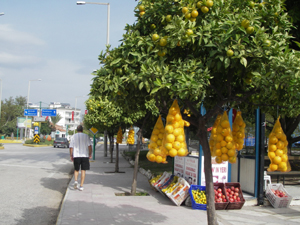 |
|
On our way back from Arycanda the bus made a stop at a sorting- and packing plant where we hade the opportunity to see how the work was done. The fruit is sorted by hand.
|
 |
|
Lemons are being sorted…
|
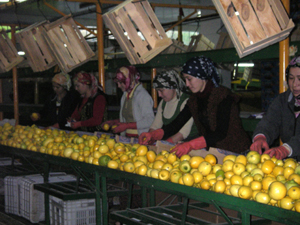 |
|
Pomegranates are another fruit being grown both for their own market as well as export.
|
 |
|
A few facts and statistics: |
|
|
Turkey is completely self sufficient when it comes to agricultural products. The country consists of 15% meadows and pastures. 29,5% is forest and 33,5% is arable land. 22% other. According to 2003 figures vegetable products amounted to 76,4% of the total agricultural produce of which 75% were fruit and field crops. Turkey is the worlds biggest producer of hazel nuts, figs, apricots and raisins. The production of fresh vegetables, grapes, tobacco, wheat and cotton are also leading products. They are also in the forefront when it comes to exporting mining products such as marble, natural stone and a large number of minerals.
|
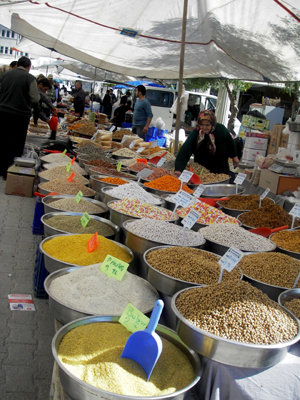 |
|
The market |
|
|
The famous market sets up its’ stalls on Saturdays and people travel here from far distances to get their wares. There is an abundance of fruit and vegetables. Nuts, of course, and everything else that belongs to a market. Here a few pictures.
|
 |
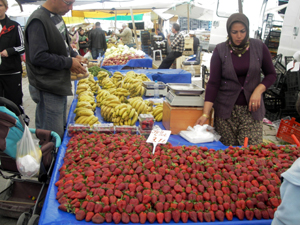 |
 |
|
We buy our bread at a bakery and often the bread is hot from the oven. A loaf costs 60 kurus, i.e. 3kr or 30 pence. The V.A.T. varies and is often 18%, but on bread it is a mere 1%. The minimum wage is 600 lira and the average wage is 1 500 lira per month. |
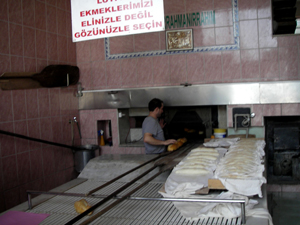 |
|
Concerts |
|
|
Ewald, from Netherlands, often arranges trips to concerts and other performances in Antalya for us sailors. For a mere 35TL we go by bus (120km one way) to Antalya and also get the entrance fee included. This time we went to a Mozart concert. We had a “small” meal before the performance which we paid for ourselves. This time it cost us 16TL for two people. This is a picture of the starter.
|
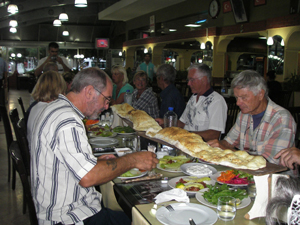 |
|
The Culture house was beautifully lit when we arrived…
|
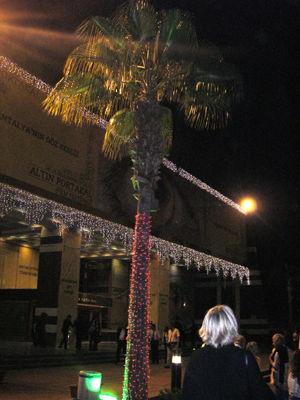 |
|
Earlier in the day we went shopping at a big shopping centre. We didn’t buy so much. We were wandering around and stated that “we don’t need that… nor that either!” But we did buy Wasa crispbread!
|
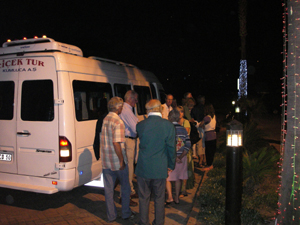 |
|
Antalya |
|
|
An easy way to travel around is by bus, or Dolmus, as they are called here. We went on an outing by ourselves to Antalya, to do a bit of sightseeing in this old and beautiful city. The founder of Antalya, or Attaleia as it was called then, was Attalus II of Pergamum (r. 159-138 B.C.).
|
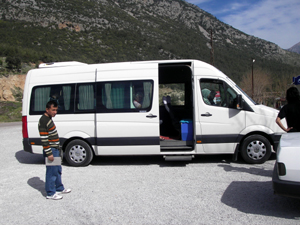 |
|
Attaleia , known during the Byzantine times as Adalia, was an important port. During the Crusades Adalia often served as a port for the Christian armies that sailed from here to the Levant thus avoiding the long and difficult march across Asia Minor. A travelling Arab from the 14th century called Ibn Battuta describes in his journal the hospitality of the town. He tells us about “The Young Brotherhood”, who’s task it was to welcome and take care of visiting guests. Abn was offered food, entertainment and lodgings during his stay without having visited the city previously. Overwhelmed by the generosity he carried on with his travels. |
|
|
The most prominent monument in Antalya is Yivli Minare Camii, “The mosque with the fluted minaret”. The minaret is built of red-pink bricks with blue-green inlays of tiles from Seljuk. The Sultan Alaettin Keykubat I had it built 1219. The whole town consists of remnants from different time periods in history, which I won’t go into this time. It is nevertheless very interesting…
|
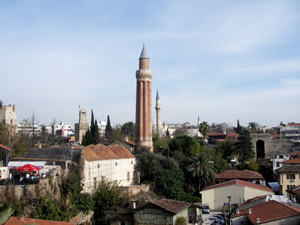 |
|
We visited the old market, or the Bazar, as it is called here. We expected to see old Turkish artifacts, but were a bit disappointed when we saw all the different stalls with “ goods”, trainers, masses of T-shirts, bags and belts. The stallholders were very pushy, which is not acceptable to us. But, I suppose they have to make a living as well.
|
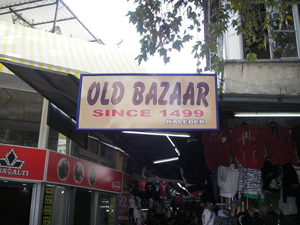 |
|
On our way to the harbour we walked through the old town and saw examples of Turkish handicraft. Very beautiful.
|
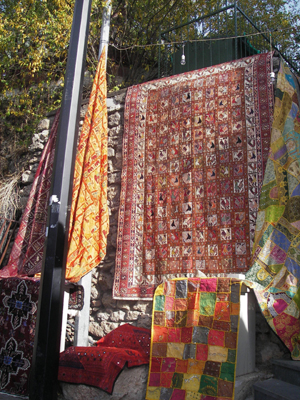 |
|
We often needed to stop for liquid refreshment in the heat…
|
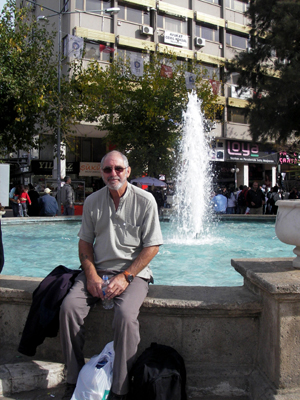 |
|
Today there are about 1,8 million people living in Antalya. |
|
|
Weather |
|
|
Yes, it was nice and warm the whole Autumn and also during the Christmas- and New Year season. The weather was gorgeous with Swedish summer temperatures of over +20o. A few weeks before Christmas we had a storm with hurricane winds. We have never experienced anything like it. It was blowing 60-80 knots (about 90 miles/hour) and hurricane winds start at about 64 knots (74 miles/hour). The noise was deafening and got worse when it started hailing ice as big as ping pong balls.
|
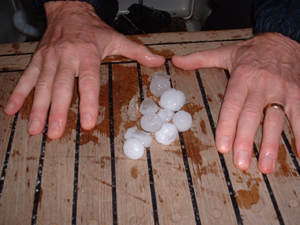 |
|
Many canopies got shredded. We were lucky getting just two holes, which we have mended temporarily. Our shock absorber split into two. Luckily the mooring line held.
|
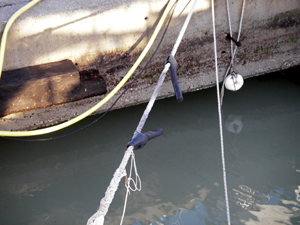 |
|
The harbour filled up with debris that had floated down the river. It only took a couple of days and everything was cleared away.
|
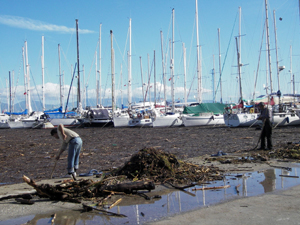 |
|
Since then we have had winds around 54 knots, i.e. 62miles/hour, at the most. A wind like that doesn’t affect us that much in the harbour basin, but the waves are pretty high outside.
|
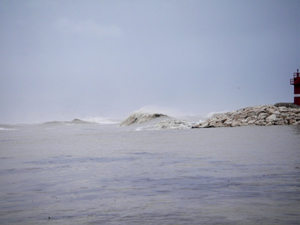 |
|
The winter didn’t get here until January and this meant that the temperature dropped to 10-15o. There was more rain, but in between there was glorious sunshine. We could see how the snow accumulated on top of the mountains. February was about the same. In March we felt that spring was on its’ way. It is flowering everywhere and the birds have got “spring feelings”.
|
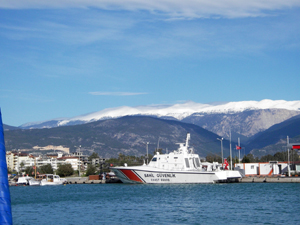 |
|
Outing to Arykanda |
|
|
On Lucia-day (13th December) we went by dolmus up the mountains to Arycanda. It is situated between Finike and Elmali. The ruins are built on five terraces along the cliff face, where there is a breathtaking view of the surrounding mountains and the valley.
|
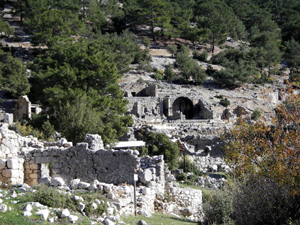 |
|
Arycanda is known as the oldest of the Lycian excavation sites and artifacts from 2000 B.C. have been found. The site is well preserved due to landslides and earthquakes burying it. There haven’t been any large settlements in later years to disrupt the area either. In the 8th century A.D. the inhabitants moved nearer to the sea and left Arycanda.
|
 |
|
Here we see the ruins of a bath complex. The largest and best preserved in Lycia. Lycia can be described as the area between Fethiye and Antalya.
|
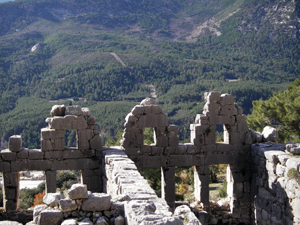 |
|
Arycanda was a well organized society with a well thought out structure. Here is the amphitheatre, build 200 B.C. and which consists of 20 rows of seating divided into seven different sections. By each row there are holes so that you could have a protecting canopy.
|
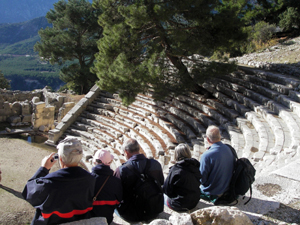 |
|
Snow covered mountains surround this fantastic place. More pictures in the gallery. |
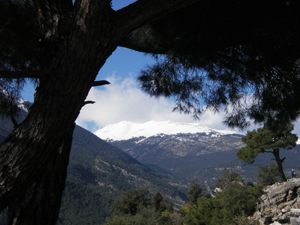 |
|
During our walks and treks we see a lot of vegetation we haven’t seen before. When it comes to trees Mike’s opinion is that all trees are oaks. So, when we saw a big thicket, Mike said that obviously it was an oak. My astonishment was complete when we found acorns on the ground! Sure enough - it was an oak. In this case a Quercus Ilex or loosely translated a “stone oak”. “I told you so…”
|
 |
|
We carried on with our outing to a little village on the road to Finike. I can’t remember the name, but we were going to stop for lunch which consisted of Gözleme. The restaurant was by a fast flowing stream. While we were waiting for our food we took a peep at the “kitchen” by the stream. This is what it looked like.
|
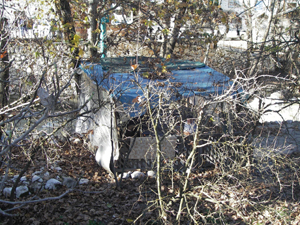 |
|
We found two ladies baking our lunch over an open fire.
|
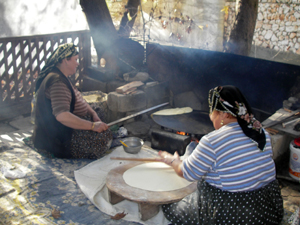 |
|
The dough is being rolled out very thinly to a large pancake. The pancake is then filled with for instance spinach and cheese, then folded and cooked. Very tasty.
|
 |
|
After lunch we went for a walk through the village and in this picture you can see the contrast between old and new. Satellite discs were seen everywhere.
|
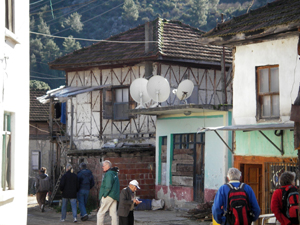 |
|
We also stopped at the fruit packing station – see pictures above - before we arrived back at the marina very satisfied with the day. |
|
|
Christmas in Finike |
|
|
Around 14 nationalities stayed in the marina over the Christmas holidays. In other words there were many wishes and desires about the celebrations. At a meeting we decided on a structure, so that it would run smoothly. Mike volunteered us as the organizers of the International Buffet and Christmas song & carol evening!! |
|
|
It turned out to be great fun when we sang to our heart’s content and enjoyed a lovely buffet consisting of food from different countries.
|
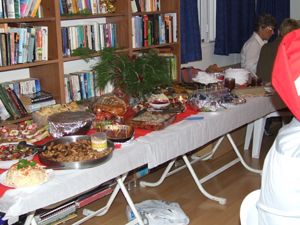 |
|
In the morning of Christmas Eve Mike enjoyed an orange in the cockpit.
|
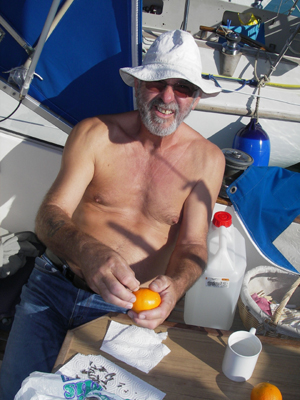 |
|
The English Christmas Carols were alternated with songs from Scandinavia, France, Germany and Monaco. Before the actual day the Swedish group, together with Heikki and Terttu from Finland, were practicing their songs.
|
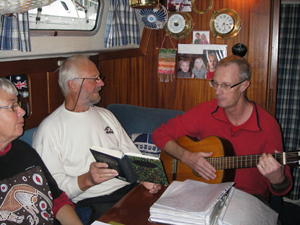 |
|
Gerd on GIM had sewn Christmas hats to all of us which was the icing on the cake.
|
 |
|
Here we are singing as a group and we didn’t think it sounded bad at all. Sune is standing next to Mike. I got carried away by the energy in the songs and was wafting the paper back and forth in time with the music.
|
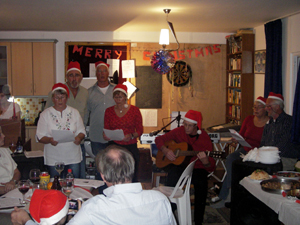 |
|
Mike had problems seeing the text and…
|
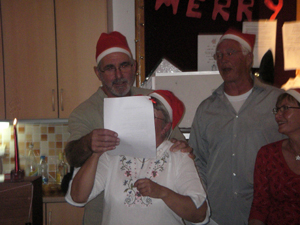 |
|
… had to forcefully keep the paper in one place.
|
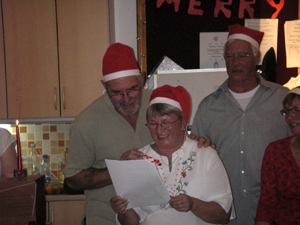 |
|
Terttu and Heikki singing Finnish Christmas songs.
|
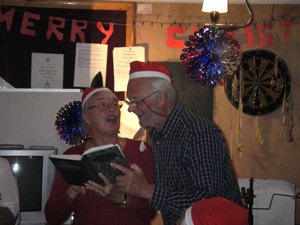 |
|
Jörgen from Denmark performed a nice ballad.
|
 |
|
The French group was quite large.
|
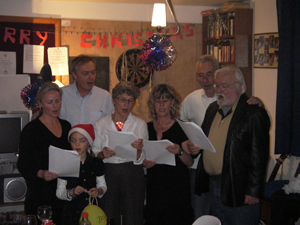 |
|
A family from Monaco sang beautifully about bells.
|
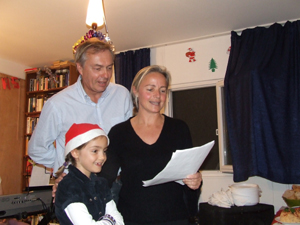 |
|
We were backed by live music performed by Steph’s mother visiting from England.
|
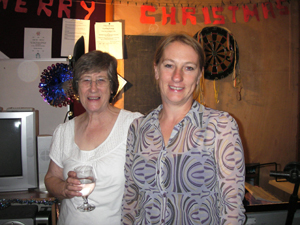 |
|
It was a very successful evening with a lot of friendly camaraderie in this our multi-cultural “mini society”.
|
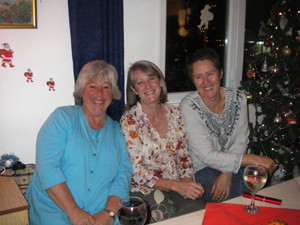
|
|
Christmas Day we went to a restaurant where Miggy and Neal had arranged for us to enjoy a traditional English Christmas dinner consisting of turkey. Well, it wasn’t this one, but a couple of other tasty ones.
|
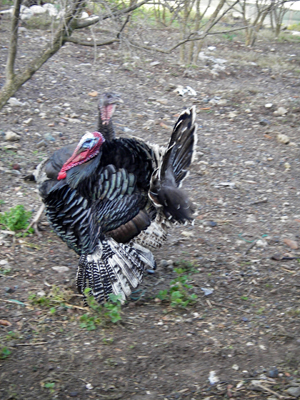 |
|
Miggy gave the restaurant a lesson in how to cook turkey the English way with roast potatoes and all the trimmings, including Brussels sprouts. |
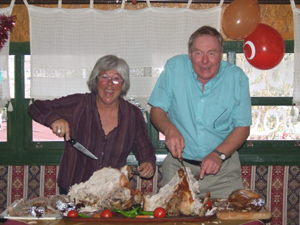 |
|
The tables were nicely decorated with the starter waiting.
|
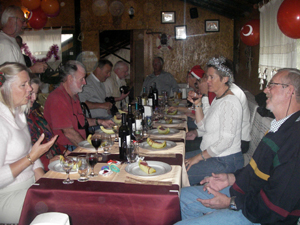 |
|
We ate with a good appetite and it didn’t take long before the turkeys looked like this.
|
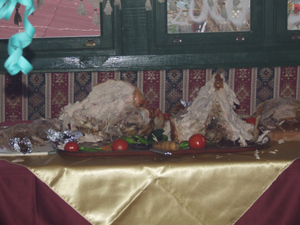 |
|
On Boxing day we went on a Treasure Hunt that Ian and Maureen had arranged. Here Håkan, Gerd and I are trying to work out some clues. |
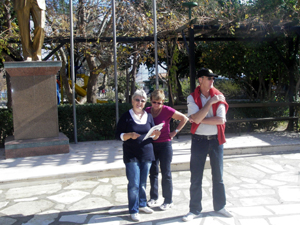 |
|
Visa |
|
|
A visa is only valid for 90 days (N/A to Swedes) and to renew these we had to make our way to Greece. This means an outing by bus to Kas and from there a boat trip to Kastelarizon. Once there you can buy duty frees and even bacon! We had time to visit a pub/bar and enjoy a drink. Here we are together with Ian and Maureen.
|
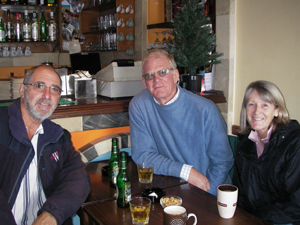 |
|
Outing to Termessos |
|
|
Termessos is at an altitude of 1 216m above sea level on the mountain Solymnos which is considered to be in Lycia. It is actually in Pisidia a little north of Antalya. The first historic reference is from 333 B.C. when Alexander the Great tried to capture the city. In Arrian’s account you can read about Alexander’s defeat. The people of Termessos occupied the two heights flanking the only way in and waited for Alexander. After a lot of fighting and tactical maneuvers Alexander found himself defeated and left. This is the only place in the area Alexander didn’t conquer. |
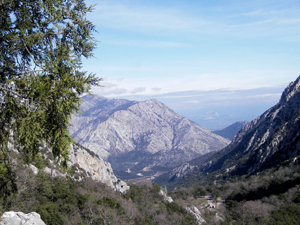 |
|
Here is also an amphitheatre with a seating for 4 200 spectators. No excavations have been made in Termessos, so the site is covered in growth and vegetation. One is in awe over how the people built the fantastic buildings and temples so high up in the mountains. These blocks of stone are not small.
|
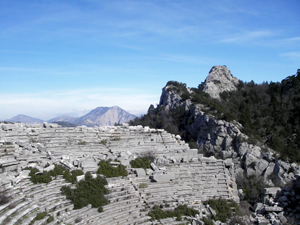 |
|
Here are parts of a temple in the Corinthian style with a lovely décor carved out in the stone.
|
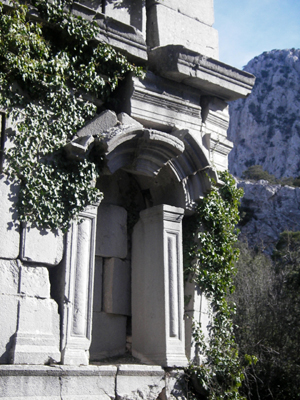 |
|
Termessos is surrounded by vast necropolis, mausolea, sarcophagi and rock hewn tombs in the Lycian style on all sides except the east. |
|
|
Why did people get buried in tombs carved high up into mountainsides? There was a belief that the soul was collected by a flying siren/being and this way it would make it easier. The tombs look like houses and are even carved in different stories. Some are full of detail. It is assumed that the tombs were carved out about 500 B.C.
|
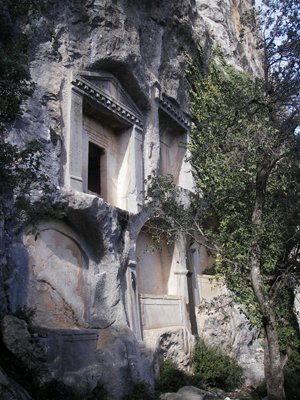 |
|
These tombs contained whole families. Sometimes they were decorated with the likeness of the dead person.
|
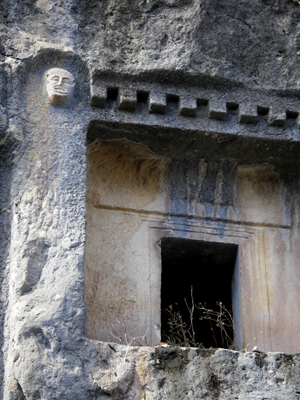 |
|
|
|
|
Here we see Sven-Erik, Barbro and Jan-Erik admiring the nice view.
|
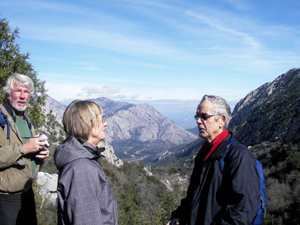 |
|
You get hungry taking part in all this cultural activity, so the bus took us to a place for lunch. A different place where we climbed up a tree house with six stories.
|
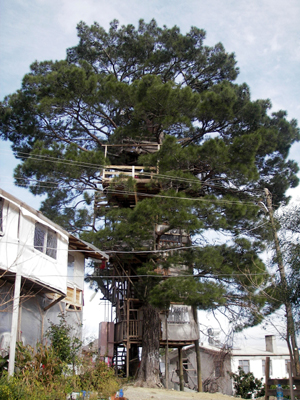 |
|
While the lunch was being prepared we sat or laid on our level and played back-gammon. Here is Jan-Erik, Barbro and Jane.
|
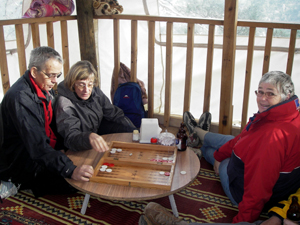 |
|
Clive is serving tea and here in Turkey it is drunk out of a glass.
|
 |
|
On the way back we stated, yet again, what an interesting country Turkey is. |
|
|
Haman |
|
|
The origins of today’s Hamam comes from the Roman and Byzantine times with the Central Asian tradition of steam baths, ritual cleansing and respect for the water. A typical Hamam is still divided into three parts according to Ottoman culture: the hot, the warm and the cool room.
|
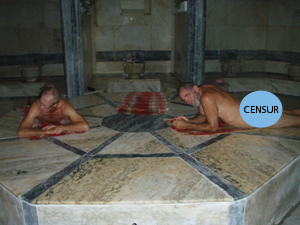 |
|
In the hot room there is a marble slab where you can sit or lie to get warm. There are small fountains or basins along the walls, where you can get doused and also create steam. In the warm room soap and water is used and you get scrubbed with a glove that feels like a Brillo-pad! In the cool room you socialize and relax with a glass of tea for instance. The Hamam was a big cultural and social institution where you found entertainment and ceremonies before weddings, etc. The men and women were separated or had access at different times, which is the case even today. This is an experience definitely recommended. |
|
|
Topic nights |
|
|
Apart from topic nights in history, the electrical system of a boat and engine, etc. we had a topic night where we presented the most useful gadget on a boat – according to the boat owner. A lot of people took part and here are a few examples. The pictures are a bit fuzzy as they are zoomed in. |
|
|
Here is Bob with an electric bat that kills insects. Very handy when you are trying to sleep and have a mosquito buzzing around your ear!
|
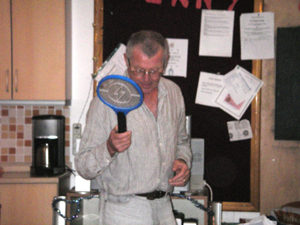 |
|
Birthe showed us her mini-oven that can be used on top of a stove.
|
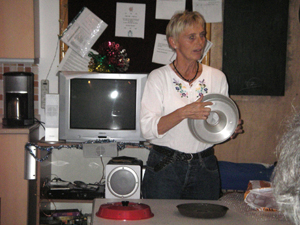 |
|
Jörgen told us how important bolt croppers are – especially when there is a problem with the rigging.
|
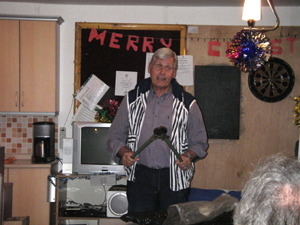 |
|
There were many, many more tips and here we see a gang of Swedes listening: Mike (Swedish?), Håkan, Gerd, Ingrid and Lars-Inge.
|
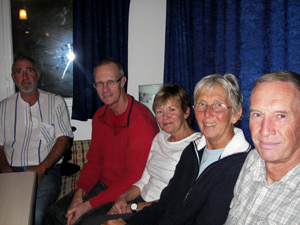 |
|
Hospital |
|
|
Mike has had problems with his back on and off, but at the end of January it was getting really bad. He ended up in hospital and got treatment and bed rest. It has been a long and laborious recuperation. He is now better and increasing his training. You just have to accept that if you want to feel healthy and good in yourself, as human beings we have to exercise, move and strengthen our muscles in a way that suits us best. Having said that, it doesn’t mean that is has to be boring!
|
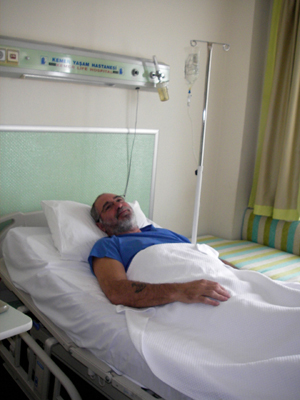 |
|
History |
|
|
There are a lot of sources describing the history of Turkey, which is a very complex one. Different continents are meeting here with their cultural and religious differences. A lot of books have been written covering this subject and I am not going to quote all of them. Only a few parts which we ourselves have found especially interesting. The history spans from 8 500 B.C. to today’s date.
|
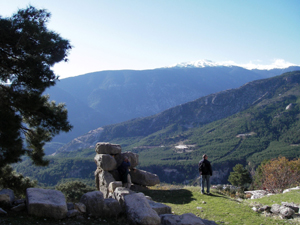 |
|
In both the Old Testament and the New Testament the Asiatic Turkey, also known as Anatolia, is described where critical incidents took place. Not least Noah and his Arc, where it is assumed that his sons and the animals saved built a new world. In the book “Biblical Sites in Turkey”* it is described how the sons married and had children, settled in different parts of the country and thus created different nations. St. Paul was also born in Anatolia. There are ruins and artifacts from different peoples and times all over Turkey.
|
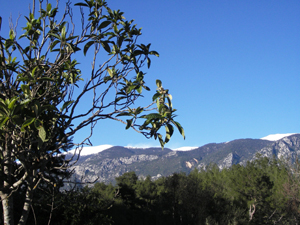 |
|
|
|
|
As previously mentioned the Ottoman Empire existed during 1250 – 1923. The Republic of Turkey was born 1923 and its’ first president was Mustafa Kemal Attatürk. The national day is the 29th October which is celebrated enthusiastically. Here is a statue of Attat¨rk by the park of the same name in Finike. He had a motto: “Peace at home and peace abroad”.
|
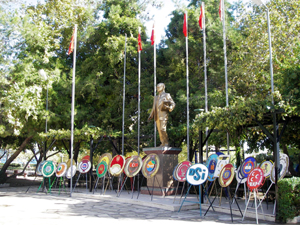 |
|
Many new reforms were brought about by government decisions. A few examples: - The Caliphate was abolished 1924 - The state was being proclaimed a secular one in 1928. - All schools were put under the Ministry of Education. - 1926 the law was changed from Islamic canonical law to laws based on Swiss, Italian and German law codes. Example: Marriage became a civil contract under this new law. - The Gregorian calendar replaced the Islamic calendar and Sunday became the day of rest. - A modified Latin alphabet was introduced 1928. - European dress was adopted and the famous Fez was forbidden. - The metric system was adopted 1934. - Equality for women.
Many and big changes have been carried through during a short space of time. A quote from the above book * : “The remarkable changes in Turkey since 1923 attest to the effectiveness of these reforms”.
|
|
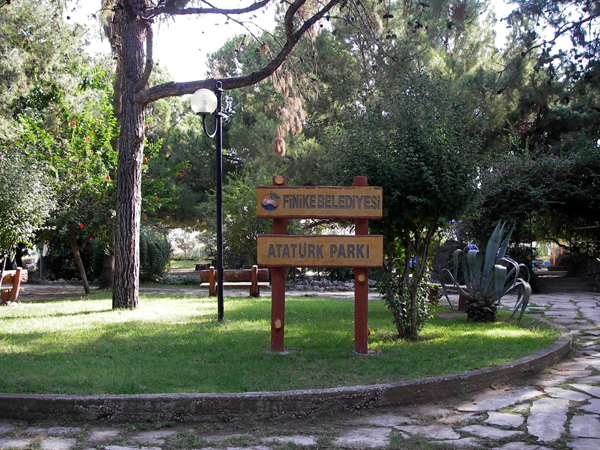 |
|
|
Outing to Melanippe |
|
|
We are on an outing again! Here is Håkan, Carsten, Sören Imbi, Eivor and Clive in the bus.
|
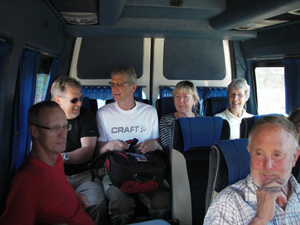 |
|
This time we are trekking to the lighthouse along the peninsula between Finike and Antalya. It was a glorious day with fantastic views!
|
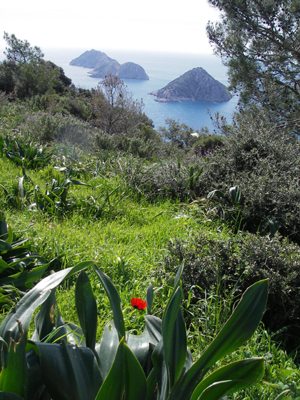 |
|
We stopped by a cove I am certain we will return to. |
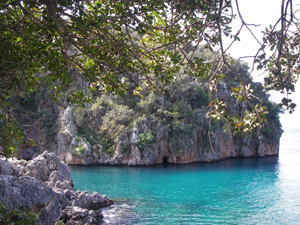 |
|
|
|
|
The path we walked on is a several thousand year old Lycian way. You could almost feel the wings of time.
|
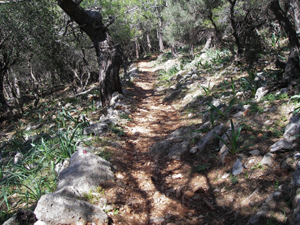 |
|
By the path I saw this plant, which’ name I haven’t found. But it is beautiful.
|
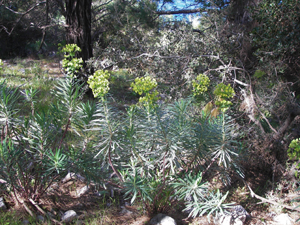 |
|
The almond trees were flowering.
|
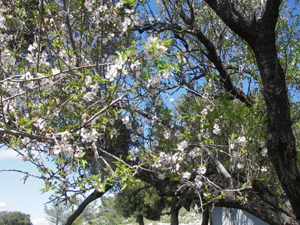 |
|
Once at the goal we had a well deserved rest before we trekked back to the bus.
|
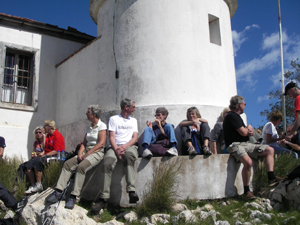 |
|
On our way back we stopped for lunch at a fish farm/restaurant called Selale. We didn’t sit at this table…
|
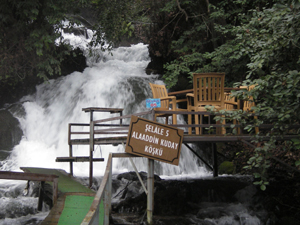 |
|
…but here, where we could see when the fish were fed. I had a lovely one for lunch! |
 |
|
After another successful outing we went back to the marina and our boats. |
|
|
|
|
|
In conclusion |
|
|
Our time in Finike has been filled with a lot of laughter, friendship, knowledge gained and challenges. We have enjoyed our stay here. So much that we have decided to stay next winter here as well. There are several of us returning in the Autumn and we are looking forward to seeing everybody again. We have only scratched the surface when it comes to Turkish culture and history. The countryside is beautiful and the people friendly and helpful. We have everything we could wish for in the marina, so the decision to return was not difficult.
|
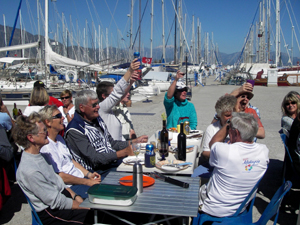 |
|
Before that happens we are looking forward to an enjoyable sailing season with a lot of sun, swimming and good books to get engrossed into. I also intent to spend some time on my new hobby – water colour painting. We wish everybody a glorious summer and we will get back to you with stories about our summer adventures in the Autumn!
|
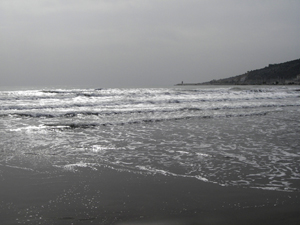 |
|
|
|
| GÜLE GÜLE! | |
